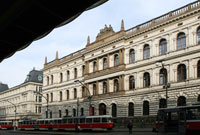Nano4inno- Nanotechnology and New Materials for Business Innovation

7 Jul 2010
27. 09. 2010—27. 09. 2010 - The international thematic seminar Nano4inno with Partnering brokerage event organised by Technology Centre AS CR will be held in Prague (Hotel Diplomat) on Monday, 27th September, 2010.
Eight czech days for european research
1 Jul 2010
The Czech Ministry of Education, Youth and Sports in cooperation with the Technology Centre ASCR is organizing on October 26th in Prague eighth year of the Czech Days for European Research conference.
The Fourth ad hoc workshop, 12 July 2010
1 Jul 2010
Ad hoc workshops are small two days workshops organized by authors of the crystallographic software Jana2006. The topics and dates are selected by participants.
12 Castle Meeting on Paleo, Rock and Environmental Magnetism 2010
1 Jul 2010
We will follow the tradition of the previous eleven meetings held each other year since 1988, promoting the information exchange on fresh results in palaeomagnetism, environmental magnetism and physical principles of rock magnetism.
Theory and method in archaeology of the Neolithic
9 Jun 2010
26th -27th October 2010 - Meeting of researchers interested in the Neolithic of Central Europe. The seminar will be focused on the main topics such as the role of material culture and its appropriate method of analysis, land use and environment, new scientific methods of qualitative analyses of materials and sediments.
DNA decorated by attachment of other molecules
9 Jun 2010
Scientists from the Institute of Organic Chemistry and Biochemistry ASCR have developed a novel simple and efficient methodology for attachment of other molecules to DNA. They prepared DNA bearing very reactive chemical functional groups that can be readily (in one step) linked to diverse other molecules e.g. for studying of molecular mechanism of important biological processes or for labeling of DNA by color or electroactive markers. This methodology has a promising potential for a broad range of applications in interdisciplinary area between chemistry and biology.
CONDUCTING POLYMERS - Formation, structure, properties, and applications
9 Jun 2010
10–14 July 2011 - 75th Prague Meeting on Macromolecules be focused on the main topic - CONDUCTING POLYMERS - Formation, structure, properties, and applications. Characterization of conducting polymers by spectroscopic methods. Modelling and simulations. Molar masses and molecular architecture. Electrical, magnetic, mechanical, optical and other physical properties of conducting polymers.
Consequences of being rich: wealth and population are key drivers of invasive species in Europe

8 Jun 2010
A new study of biological invasions in Europe found they were linked not so much to changes in climate or land cover, but to two dominant factors – more money and more people. Wealth and population density, along with an increase in international trade and commerce, were the forces most strongly associated with invasive species that can disrupt ecosystems and cause severe ecological or agricultural damage, scientists said.
Membrane lipids and cytoskeleton dynamics are intimately interconnected in plant cells

6 Jun 2010
Membrane lipids and cytoskeleton dynamics are intimately interconnected in the eukaryotic cell, but only recently have the molecular mechanisms operating at this interface in plant cells been addressed experimentally. F-actin microfilaments and microtubules are major constituents of the cellular cytoskeleton in plant cells as well. Nevertheless, plant cells are strained by developmental as well as environmental mechanical challenges because of the crucial structural and regulatory function of the cell wall.










